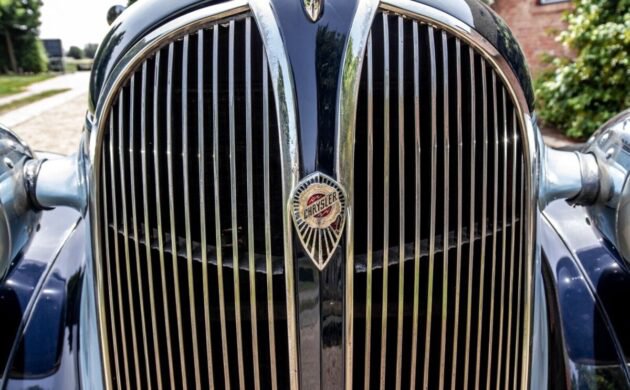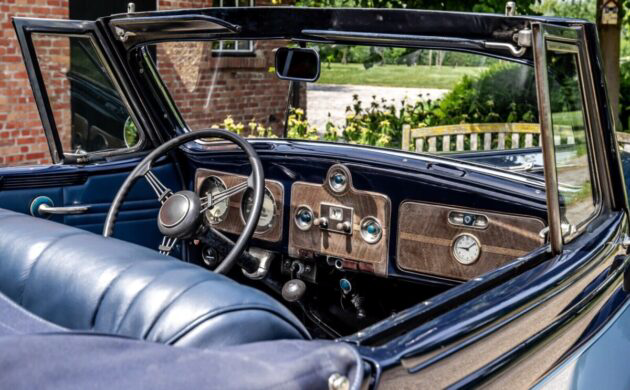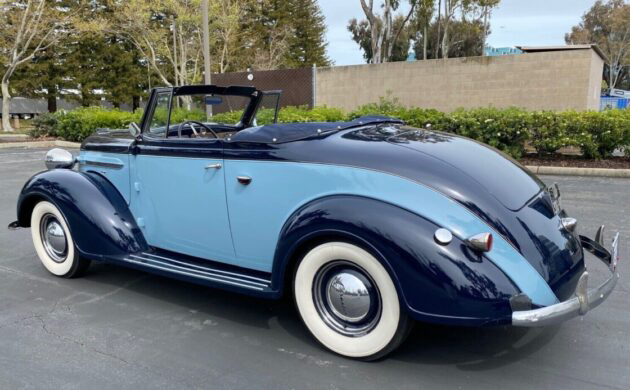Chrysler’s pre-war exports were a confusing medley of Dodges sold as Plymouths, Plymouths sold as Chryslers, and Dodges sold as Dodges. The company began its export program during the Great Depression and managed to send about 1100 vehicles overseas starting in 1932. Our subject car was sold into Cognac, France, having been built for that market from new. Here on eBay is a very attractive 1937 Chrysler convertible coupe, bid to $20,700 with the reserve still in place. The car is located in San Mateo, California. The private seller is not inclined to be particularly forthcoming about his car’s history or condition, so short of calling for an interview, we’re going to have to guess.
What we do know is that the car is also for sale here on Hemmings for $50k, and the seller managed to mention “Plymouth” in that listing. The grille does appear to identify the car as a Plymouth. The 1937 Chryslers utilized an expansive, horizontal version of the Air Flow grille – the last of that design. By 1938, the company began to tame its grille. This vertical style is punctuated by a Chrysler badge – probably placed there to establish status in the export market. Here’s the mighty similar ’37 Plymouth P4, and this happens to be a convertible coupe as well. The sale car’s Marchal lenses are an elegant touch, though in the day, they would have been de rigueur for France.
The interior is wonderful, accented by Chrysler/Plymouth’s new-for-’37 “safety-styled” dash, designed to avoid snagging clothing. The dash is painted, with some fading apparent. But the seats are in excellent condition, including the rumble seat. The seller indicates that the car comes with its original license plates and registration from 1937.
The tidy rear end is also similar to the P4. The motor was apparently turned shy when it was time for the photo shoot, but the mill is probably the 201 cu. in. in-line six-cylinder that decked the engine bay of most Plymouths, and many Chrysler and Dodge vehicles during the mid-1930s. The 201 is good for about 80 hp. The factory transmission mated to that motor was a three-speed floor-shift manual. The seller does note that the car needs some TLC to keep it running and currently, its starter motor is posing problems. The elegant blue paint, clean wide whitewalls, intact trim, and plush interior bespeak a caring owner, but I’m not sure that’s enough to boost the price all the way to $50k. What do you think?






Classy car, Michelle and interesting part of American car manufacturing. It’s a novel note that it made its way back here to be shown again as it left the US some 86 years later. Cool.
The grill has at first glance a similarity to the Plymouth you referenced. It’s a beautiful car that should fetch a “pretty penny.”
According to Willem L. Weertman’s excellent reference book, Chrysler Engines: 1922-1998, the Dodge and Plymouth divisions used a 23” (23.4” at the head deck) flathead in 190, 201,218, 230 cubic inches, using 3.125” bore and 4.125” stroke, 3.125” Bore, 4.375” Stroke, 3.25” Bore, 4.375” Stroke and 3.25” Bore, 4.625” Stroke respectively, but only 201 and 218 were in production in 1937.
DeSoto and Chrysler divisions used a 25” flathead (25.7” at the head deck) in 228.1, 241.5, 236.7, 250.6 and 264.5 cubic inches, 3.375” bore, 4.25” Stroke, 3.375” Bore, 4.5” Stroke, DeSoto Only 3.4375” Bore, 4.25” Stroke, 3.4375” Bore, 4.5” Stroke and 3.4375” Bore, 4.75” Stroke respectively.
In 1937, Chrysler used the 241.5”, short skirt, 4-main bearing variant (differing from the deep skirt 241.5” DeSoto Airflow engine which ended production in 1936).
The DeSoto and Chrysler engines had bigger bores and valves as compared to the Dodge and Plymouth Flathead Engines. DeSoto and Chrysler also used Aluminum heads more than Dodge and Plymouth. But with the arrival of the Chrysler Fire Power Hemi and Polyspherical engines, and the DeSoto Fire Dome Hemi and Poly engines, the Chrysler and DeSoto engines were relegated to Industrial Power, while The Dodge Red Ram Hemi and Poly engines lessened the demand for the 23” Flatheads only the Plymouth 23” flat head engine remained as its only engine in 1955 and Plymouth was allowed to use Dodge’s Poly engines until the Plymouth 276, 303, 301 and 318 (as well as a single year 1959 Dodge 326) Polyspherical V-8s arrived in 1956.
The 230 Flathead soldiered along as Dodge and Plymouth’s base engine until 1960, getting raised compression and at least one Dodge variant got a 2-barrel carb and intake. The Slant-Six supplanted the Flathead 6 in 1960. By the 1960s the last of the 25” Flatheads had been used up in M-37s, forklifts and welders while and the 23” flatheads soldiered along in farming combines, Oliver Tractors, and WM-300 Power Wagons, finally disappearing in 1968. The flat head was made redundant in 1969, by the then 10 year old slant-six.
The grille put me in mind of a Hotchkiss that a friend of mine has. Given that it was built for Europe, that’s interesting. It’s a nice-looking thing.
I’d like to know how many of these Chrysler-badged Plymouths were exported to Europe and particularly to France. I have so far been unable to find mention of any others. I have a real interest in knowing more about this car’s history since I’m happy to be its new owner.
Lonnie – I do have export production figures but I can’t give you an exact number of how many of these were exported to France. I can, however, tell you how to get more information from Mother MoPar (Mrs. Stellantis now). There were a number of RHD convertibles shipped to New Zealand (where most of those still exist) and to South Africa. I am the former membership secretary of the Plymouth Owners Club and my email is benji at utma . com if you wish to contact me. Your car has the early and rare vent windows that you might not be aware of. Looking forward to hearing from you.
I’m not sure where my first comment disappeared to – while I can’t tell you how many were of these were shipped to France, I do have export figures for these cars and I can tell you how to get further information on the car from Mother MoPar (now Mrs. Stellantis). I am the former membership secretary of the Plymouth Owners Club and would like to have you contact me for further information on the car. My email is benji at utma. com . FYI – this car has the early and rare fixed vent windows. Looking forward to hearing from you.